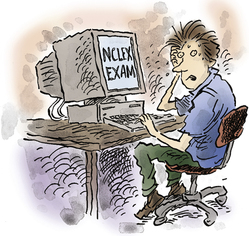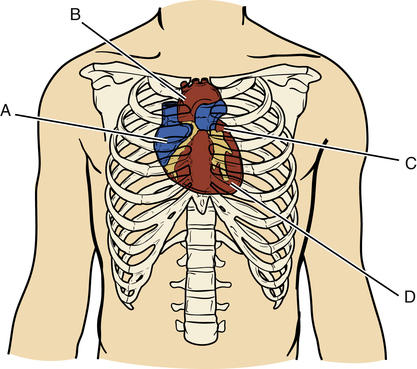After studying this chapter, the reader will be able to: 1. Explain the purpose of the NCLEX-RN examination. 2. Evaluate various methods of preparation for the NCLEX-RN examination. 3. Create a personal plan for preparing for the NCLEX-RN examination. 4. Analyze the relationship between the nursing process and client needs as they relate to NCLEX-RN test items. 5. Compare various review courses designed to aid in review for the NCLEX-RN examination. Requirement that must be met to legally practice or work as a registered nurse (RN). Licensure is a prerequisite to practice in each state and U.S. territory. Computer adaptive testing (CAT) A type of testing taken on a computer, in which a person is given a test question to answer, followed by a subsequent question that is leveled based on the whether the candidate correctly answered the first question. For example, a person missing a question dealing with assessment might be given another assessment question to determine the person’s competency with assessment, or a person answering a knowledge-level question correctly could receive a question at the application level of Bloom’s taxonomy. NCLEX stands for National Council Licensure Examination, an examination taken by qualified graduates of approved schools of nursing. Graduates successfully taking the NCLEX-RN examination are granted a license to practice as RNs. Additional resources are available online at: http://evolve.elsevier.com/Cherry/ VIGNETTE Consider for a moment how nursing and licensure examinations have changed as society has changed. Nursing is a reflection of society’s values, knowledge, and needs. Test items or questions found on the NCLEX-RN examination today have little resemblance to questions asked on state board examinations administered during the early part of the century. The examination of that era dealt with practical issues and consisted mainly of knowledge-based questions that had little to do with assessment, application, evaluation, or need. Consider, for instance, the following questions taken from the 1919 state board questions and answers for nurses (Foote, 1919): What are the advantages of fireplaces? How would you sterilize silkworm-gut and silk sutures? What care regarding nourishment would you give a gynecological patient to prevent a common discomfort? Give some general rules for preparing meats. Give three common complaints that the public makes about graduate nurses. This chapter helps student nurses prepare to successfully pass the NCLEX-RN examination. The purpose of the NCLEX-RN is discussed, and an overview of the format and content is given. Various strategies for preparing for the examination are given, and students are encouraged to develop a personal plan of study. The NCLEX-RN examination and licensure to practice nursing go hand in hand. To receive a license to practice as an RN in the United States and its territories, candidates must furnish evidence of competency to provide safe and effective nursing care by successfully completing the NCLEX-RN examination (National Council of State Boards of Nursing [NCSBN], 2009). There are three types of RN programs: (1) 2-year associate degree program usually found in community or junior colleges, (2) hospital-based diploma programs, and (3) baccalaureate degree or higher programs found in 4-year colleges and universities or academic health centers. Graduates from all programs take the same NCLEX-RN examination. The examination content common to all of these programs is job related and reflects current entry-level nursing practice (NCSBN, 2009). Individuals taking the examination must have graduated from approved schools of nursing. The purpose of the NCLEX-RN examination is to: 1. Safeguard the public from unsafe practitioners. 2. Assist state boards of nursing in determining candidates’ capabilities for performing entry-level RN positions. To keep the NCLEX-RN examination current, the National Council of State Boards of Nursing (NCSBN) conducts a practice analysis on a 3-year cycle by investigating current practice that entry-level nurses are performing in various health care settings in the United States. Six thousand newly licensed nurses are asked to prioritize 150 nursing care activities and state how often they perform them. These activities are then evaluated based on the context, frequency, and effect on client safety (NCSBN, 2009). Frequencies of changes to the examination are based on the practice analysis occurring every 3 years. The most recent RN practice analysis was completed in 2008. Based on the results of this practice analysis, the NCSBN revised and implemented the current test plan in April 2010. The greatest amount of time was spent in management of care (14%), basic care and comfort (14%), and pharmacological and parenteral therapies (14%), with the least amount of time spent on psychosocial integrity activities (10%). This varies slightly on all categories from the 2005 survey. To view the latest practice analysis visit www.ncsbn.org/1235.htm. In 2008, the NCSBN (2009) also surveyed newly licensed RNs, RN educators, and supervisors of newly licensed RNs to evaluate knowledge of newly licensed RNs. Interestingly, all three sets of responders rated the most important knowledge statement as “critical signs and symptoms (identify and intervene)” and “rights of medication administration.” Availability of genetic resources for client referral and “supply and resource management (acquisition and reconciliation)” were evaluated as least important (NCSBN, 2009). Laboratory values were also evaluated related to importance to memorize normal laboratory values with glucose being most important (96.08%) and normal laboratory values of phosphorous/phosphate being least important (21.01%). The NCLEX-RN examination uses Computer Adaptive Testing (CAT), which is a test-administering technique that uses computer technology and measurement theory. As a candidate answers questions on the examination, CAT adapts to the level of the candidate’s knowledge, skills, and ability. After a candidate answers a question at a particular level of difficulty, the computer then selects the next item that the candidate should have a 50% chance of answering correctly. All examinations are consistent with the NCLEX-RN examination test plan, which controls inclusion of nursing content. Candidates have ample opportunity to demonstrate their competence because the examination does not end until stability of the pass or fail result is certain or time runs out (NCSBN, 2009). Candidates taking the examination answer a minimum of 75 questions to a maximum of 265 questions. The NCSBN (2009) advises that the length of an NCLEX-RN examination be based on the performance of the candidate on the examination and has established a goal to be 95% sure of pass-fail decisions. The computer determines if a candidate passes or fails based on the following three rules: 1. 95% confidence interval rule: 95% certainty that the candidate’s ability is obviously above or below the passing standard. 2. Maximum-length examination rule: When the candidate is very close to the passing standard, the computer continues to give test items until the maximum number of items is reached; at this point, the computer disregards the 95% confidence rule and decides whether the candidate passed or failed. 3. Run-out-of-time rule: The candidate runs out of time, and the 95% confidence interval has not been determined. If the candidate has not answered the minimum number of questions, then he or she fails; if the candidate has answered the minimum number of questions, the computer analyzes the last 60 questions to determine if these questions were above or below the passing standard. A tutorial is administered before the examination actually begins, providing candidates with experience in using the computer in CAT situations. Candidates should carefully read an entire question and all possible answer options before selecting an answer. Candidates may request assistance regarding the use of the computer at any point, even during the NCLEX-RN examination. In addition, they may find it helpful to view the PowerPoint candidate tutorial before going to the testing center. This tutorial, provided by the NCSBN, may be accessed at the following website: www.ncsbn.org. Candidates taking the NCLEX-RN examination are not allowed to skip questions and return to them at a later time or to change answers to questions once an answer has been selected and entered into the computer. These actions would defeat the purpose of adaptive testing because CAT selects questions based on the examination taker’s knowledge, skills, and abilities. Candidates are not disadvantaged using this method of testing because CAT has a built-in self-correcting mechanism (NCSBN, 2009). a. A 64-year-old client who had a total knee replacement 3 hours ago and has 15 mL of serosanguineous drainage in the collection device. b. A 32-year-old client who had closed reduction of a fractured right malleolus 5 hours ago and has swelling of the right toes. c. A 9-month-old client admitted 6 hours ago with vomiting, whose vital signs are temperature, 37.6° C (99.7° F); pulse, 124; respirations, 26. d. A 6-week-old client who was admitted 2 hours ago with nasal flaring and has a pulse oximetry reading of 90%. • Hot spot (questions based on illustrations and charts). With this type of item, the candidate is asked to identify one or more area(s) on a picture or graphic. See the following example: Identify the point of maximal impulse (PMI): • Multiple-response, multiple-choice questions. The candidate is presented with a question, followed by five or more responses. The candidate is asked to check all responses that are correct; partial credit is not given. See the following example: • Fill-in-the-blank. The candidate is presented with a question to which the answer must be typed, instead of selecting from among a set of four options. In some cases, candidates may be asked to calculate values, such as dosages. A drop-down calculator is available for the candidate to use. See the following example: How many milliliters should the nurse document as the client’s intake? • Graphic option identification. The candidate is presented with a picture or a graphic image rather than text and asked to identify a particular area. • Drag and drop (prioritize). The candidate is presented with a set of responses to a question and asked to place them in order or to prioritize. See the following example: 4. Explain the procedure to the patient. 5. Remove the soiled dressing. 6. Document the dressing change. Type your answer in the box below (note: Do not use spaces or commas between the numbers in the answer.) Candidates may also be asked to click on the steps and drag items in the correct order.
The NCLEX-RN® Examination
Chapter Overview
The NCLEX-RN Examination
Purpose of the NCLEX-RN Examination
Characteristics of the NCLEX-RN Examination
Computer Adaptive Testing
Skipping Questions and Changing Answers
Question Format
Traditional Format: Multiple-Choice, One Option
Alternate Item Format
![]()
Stay updated, free articles. Join our Telegram channel

Full access? Get Clinical Tree


The NCLEX-RN® Examination
Get Clinical Tree app for offline access


